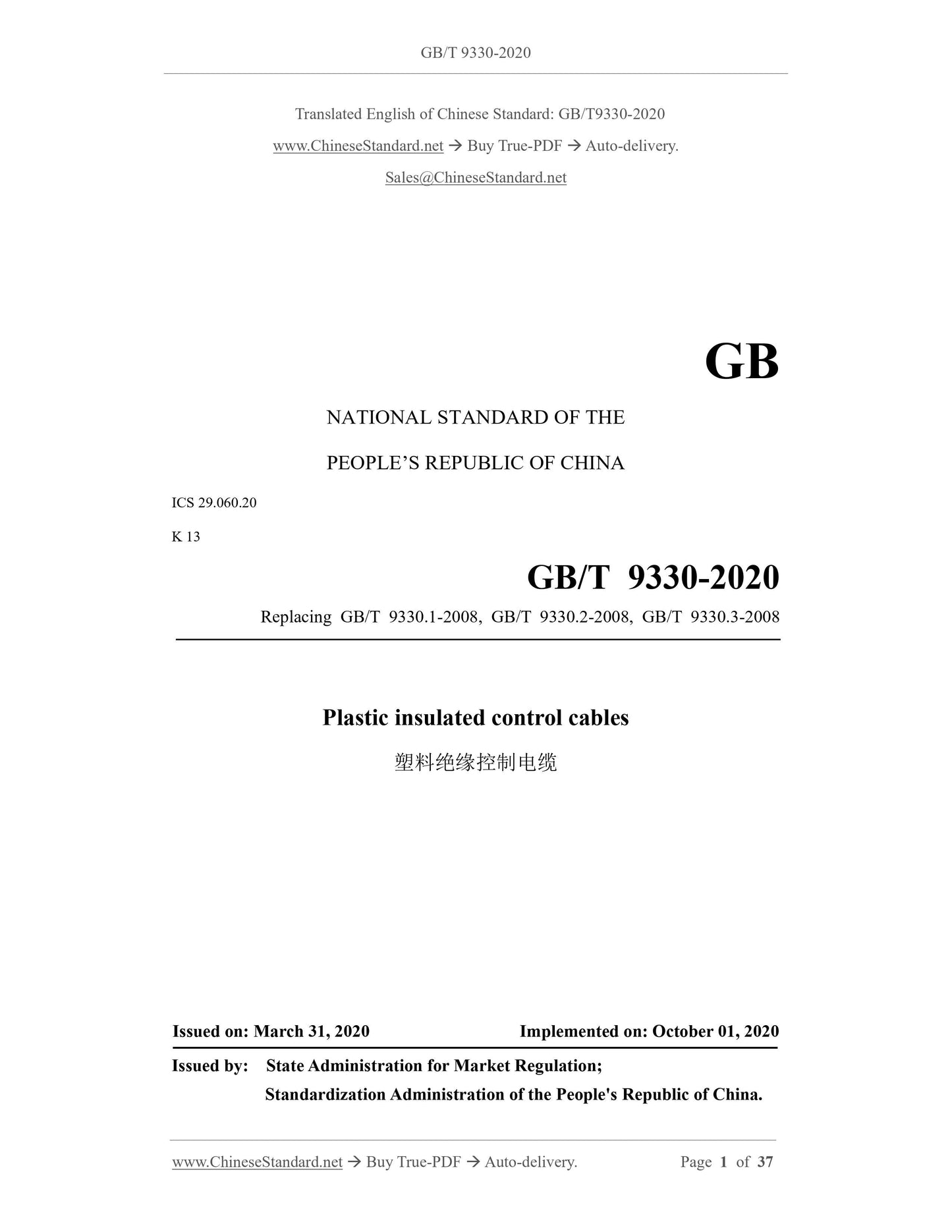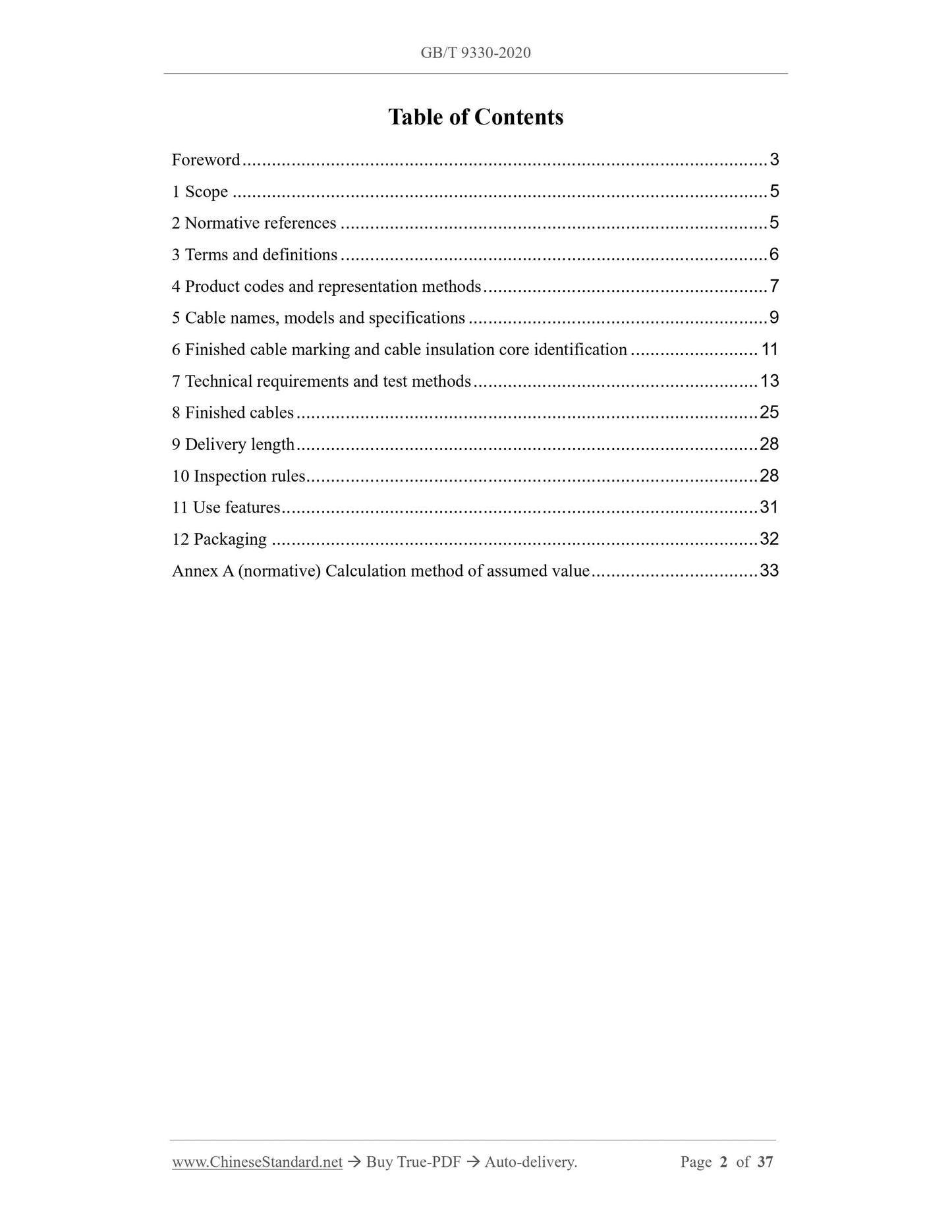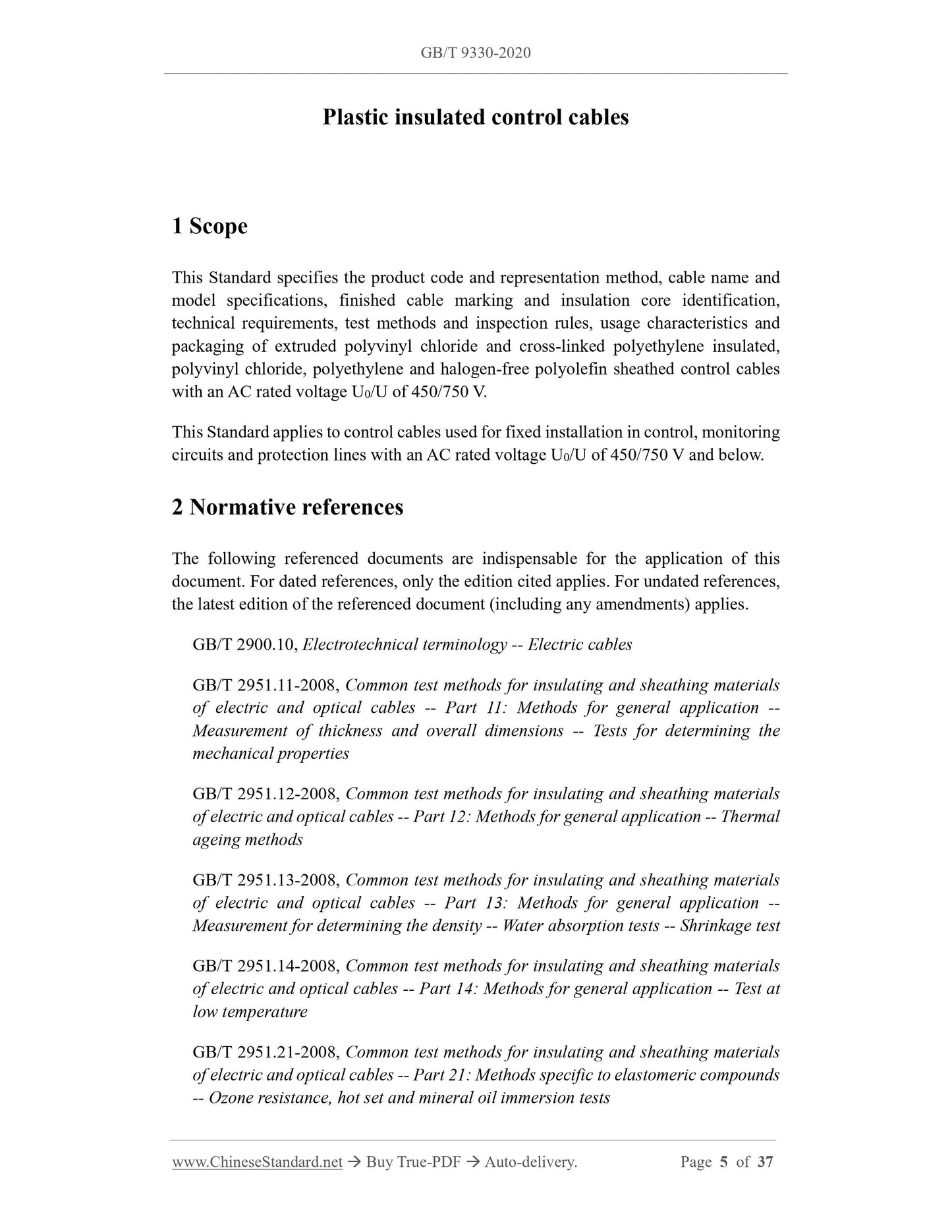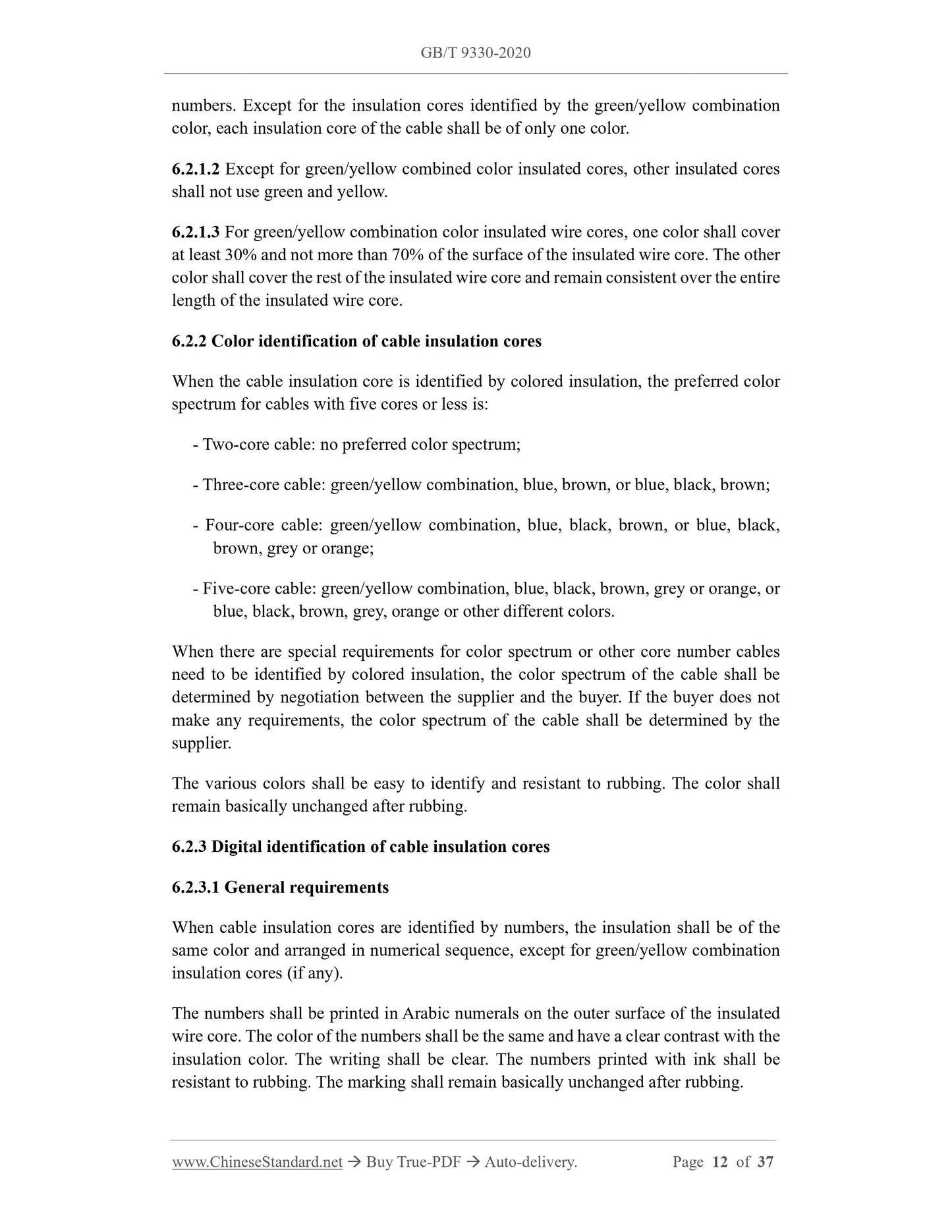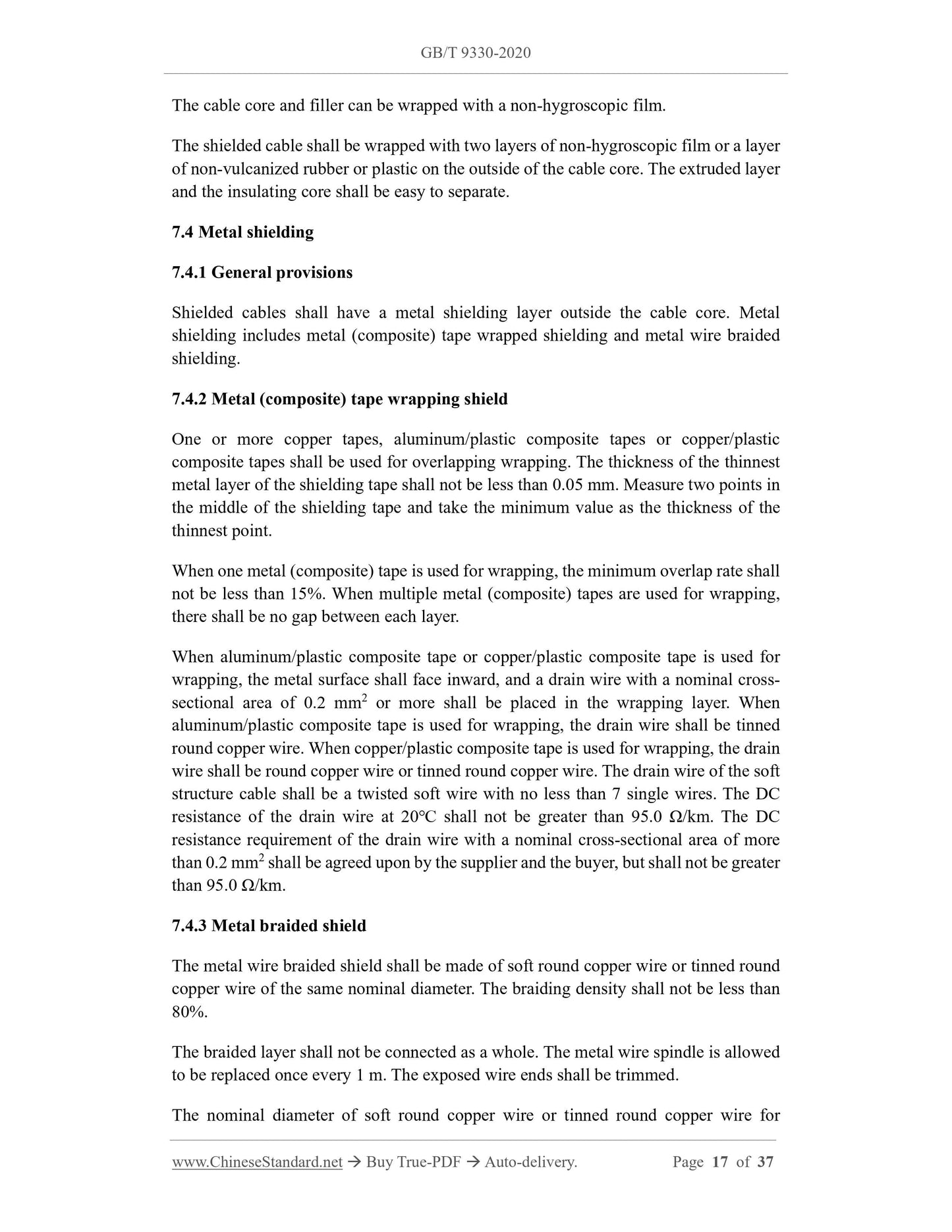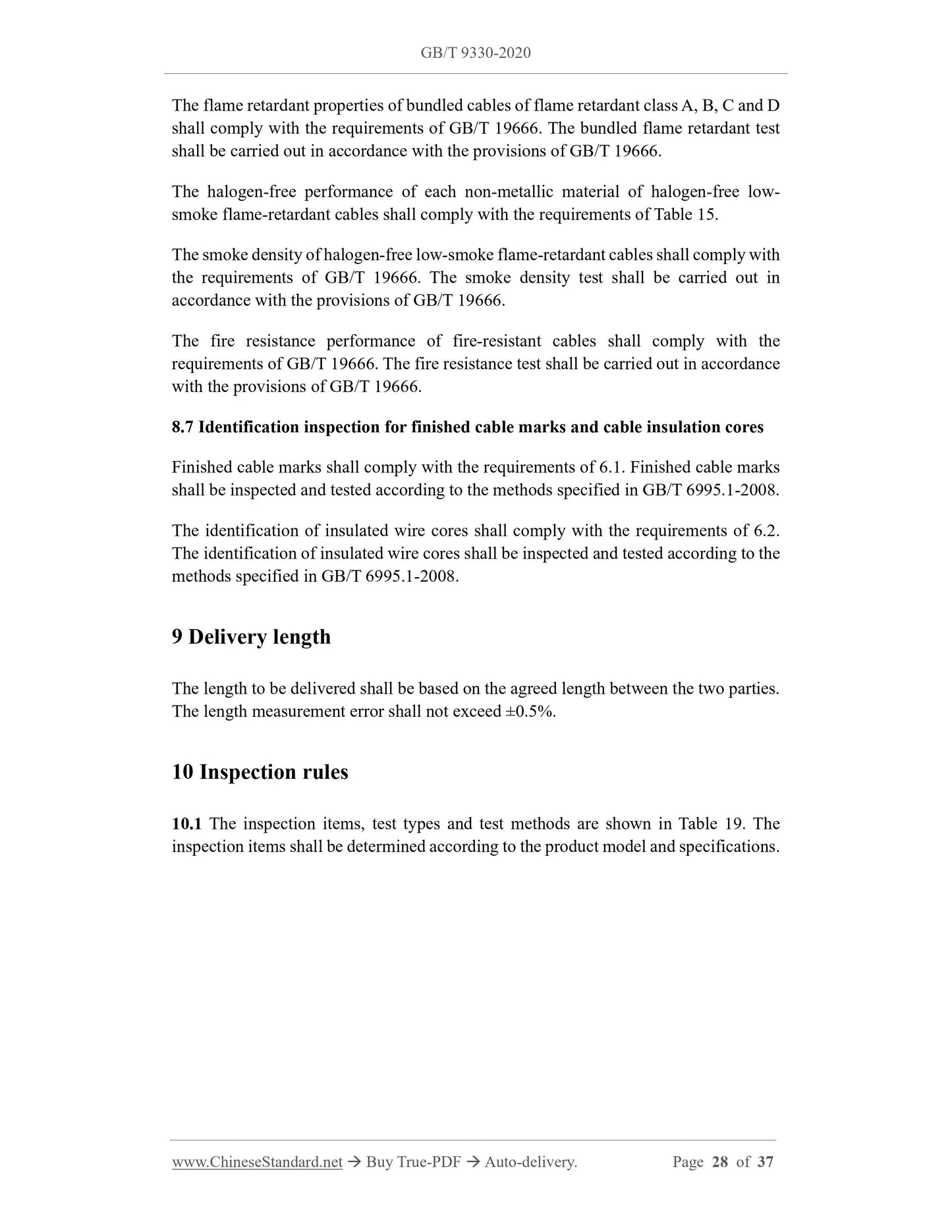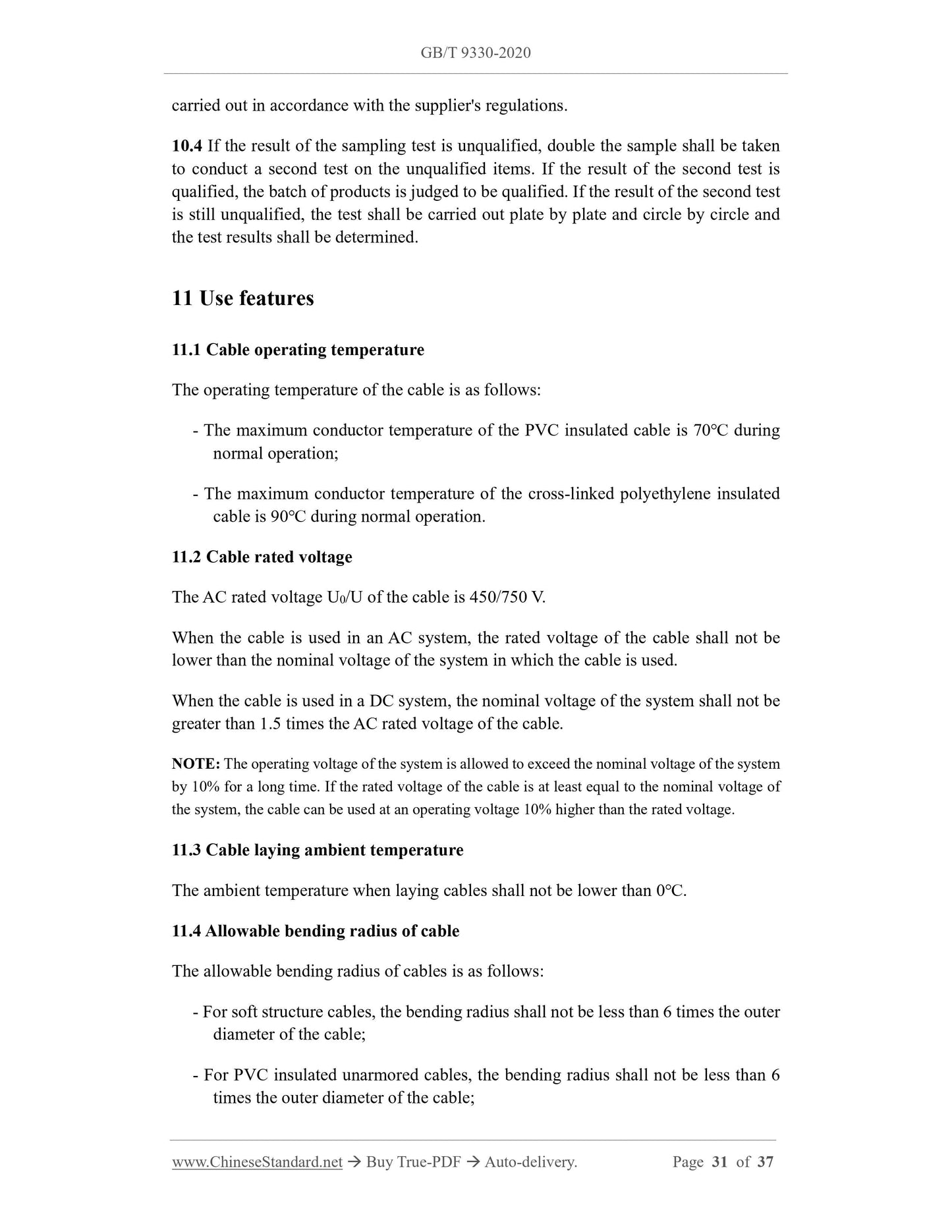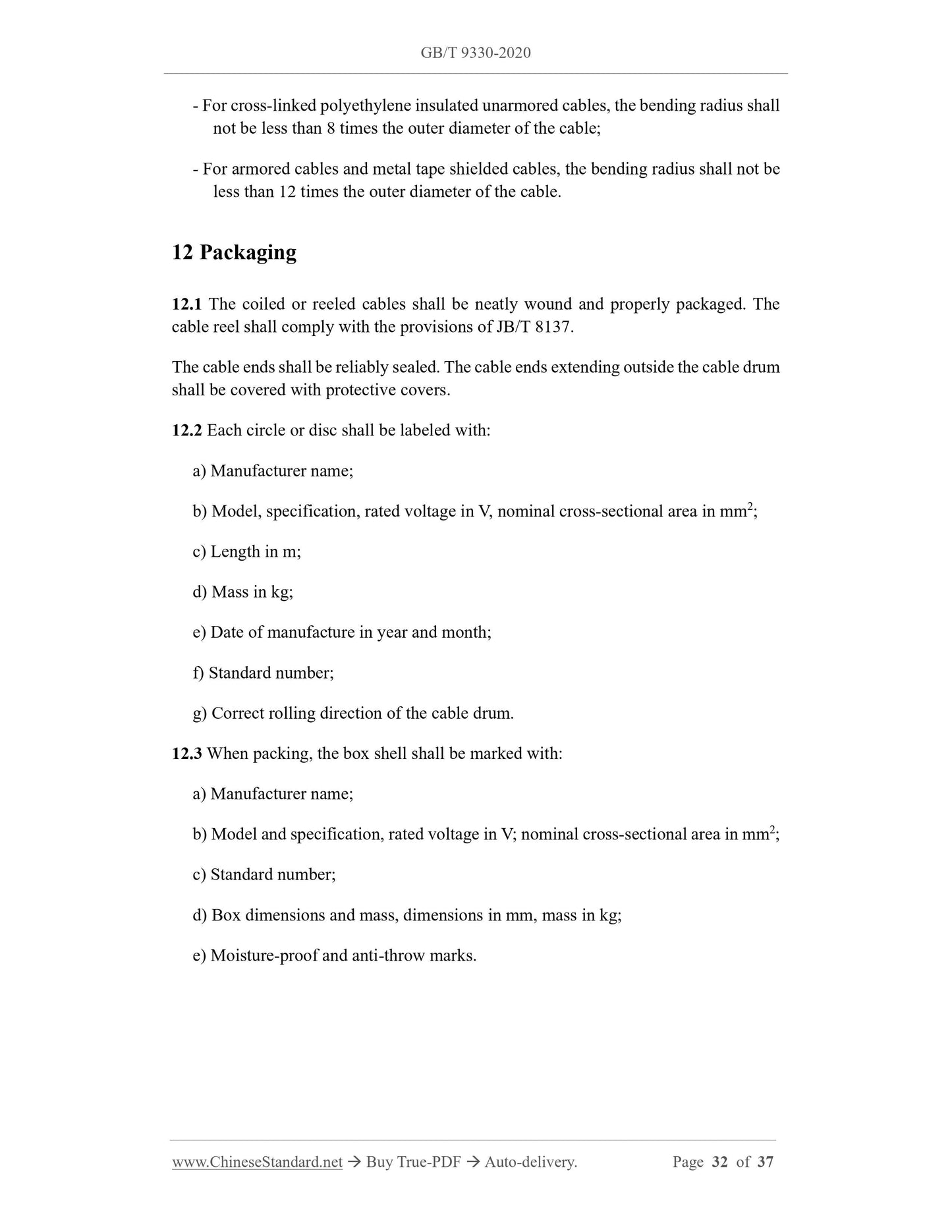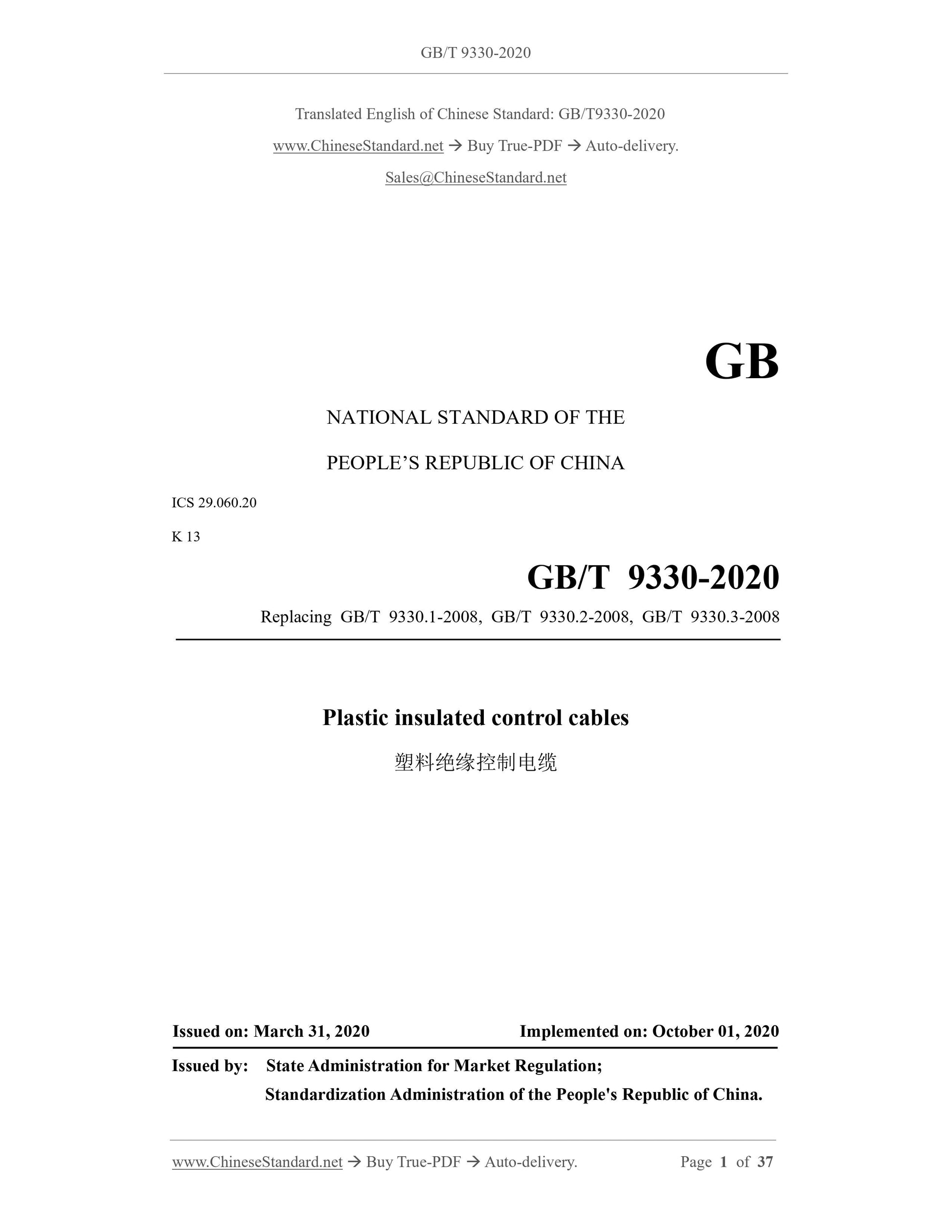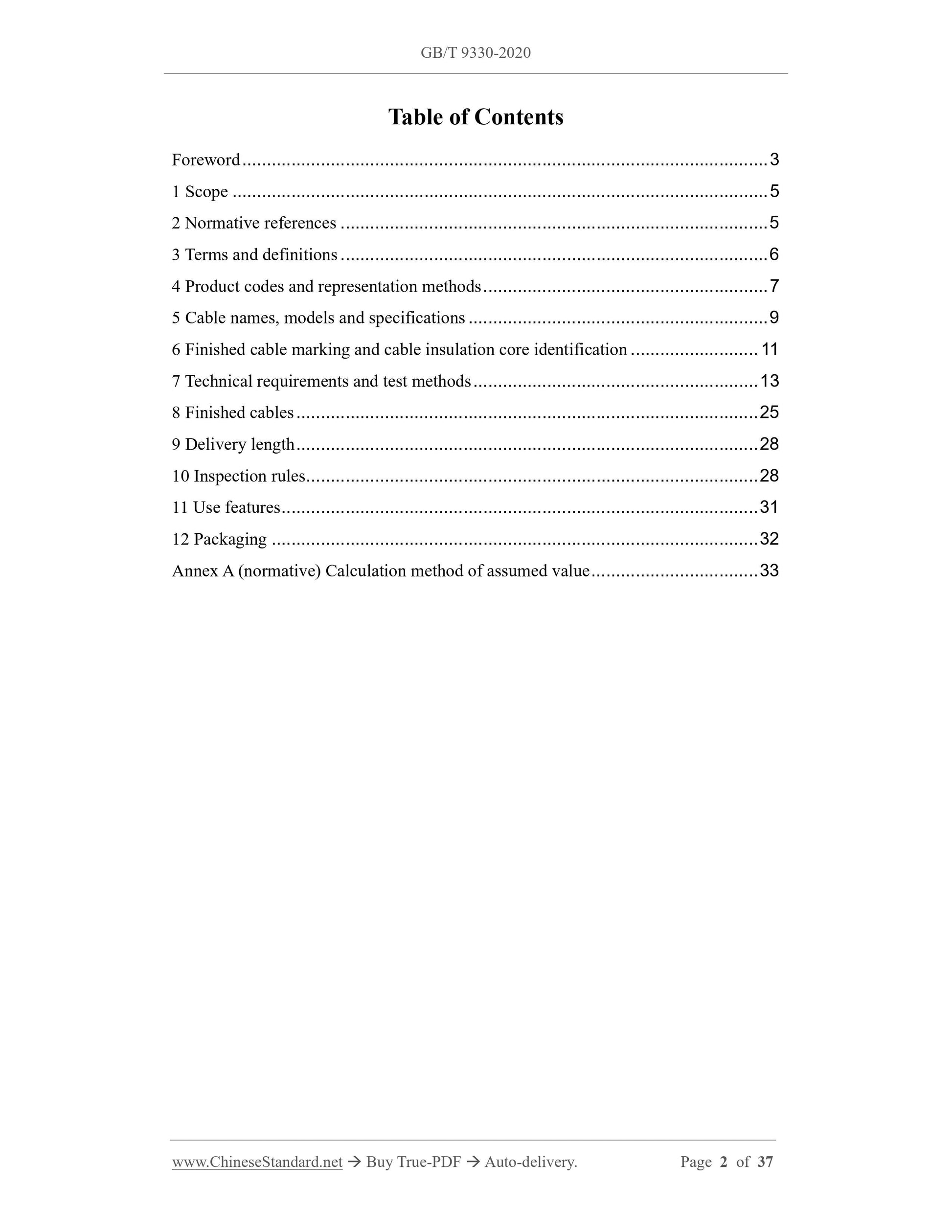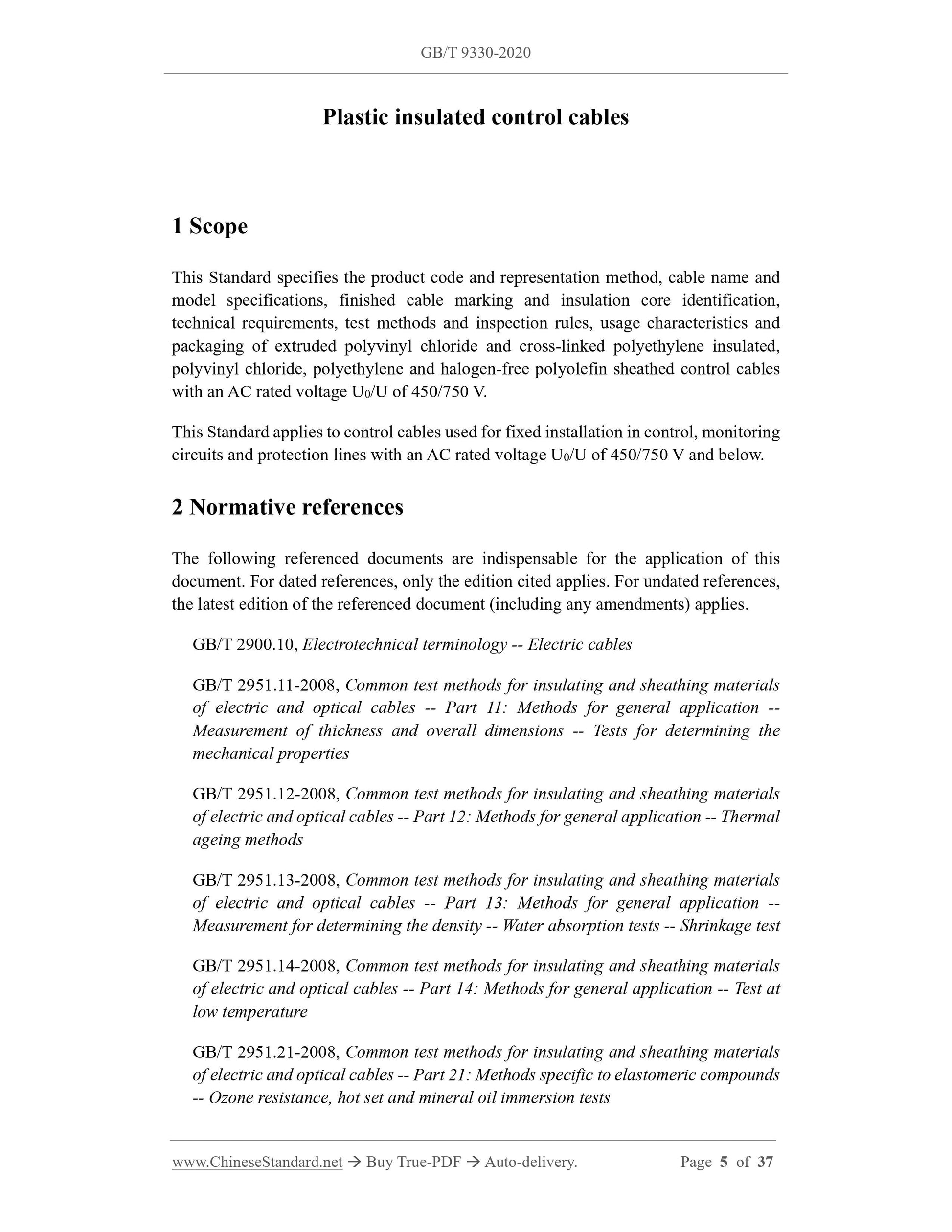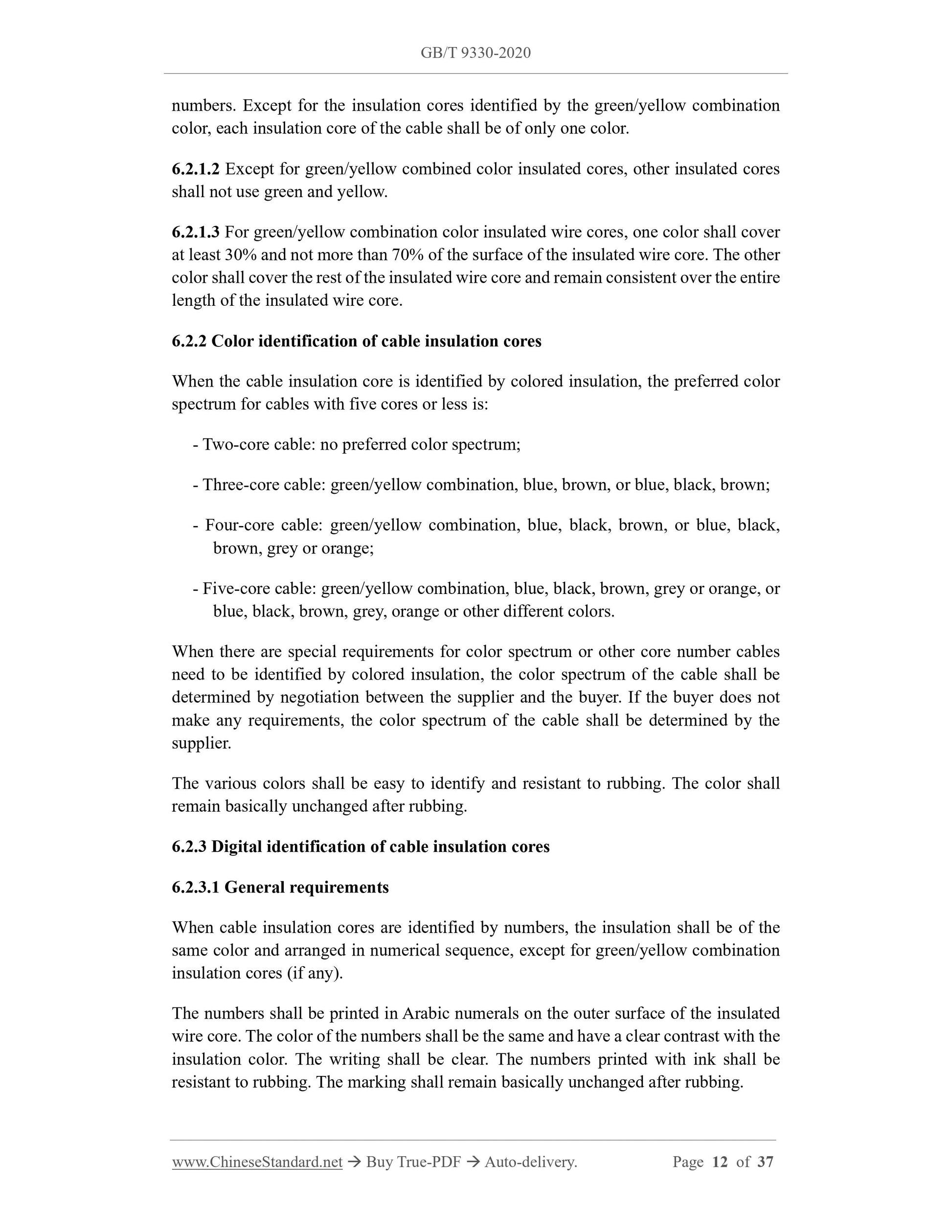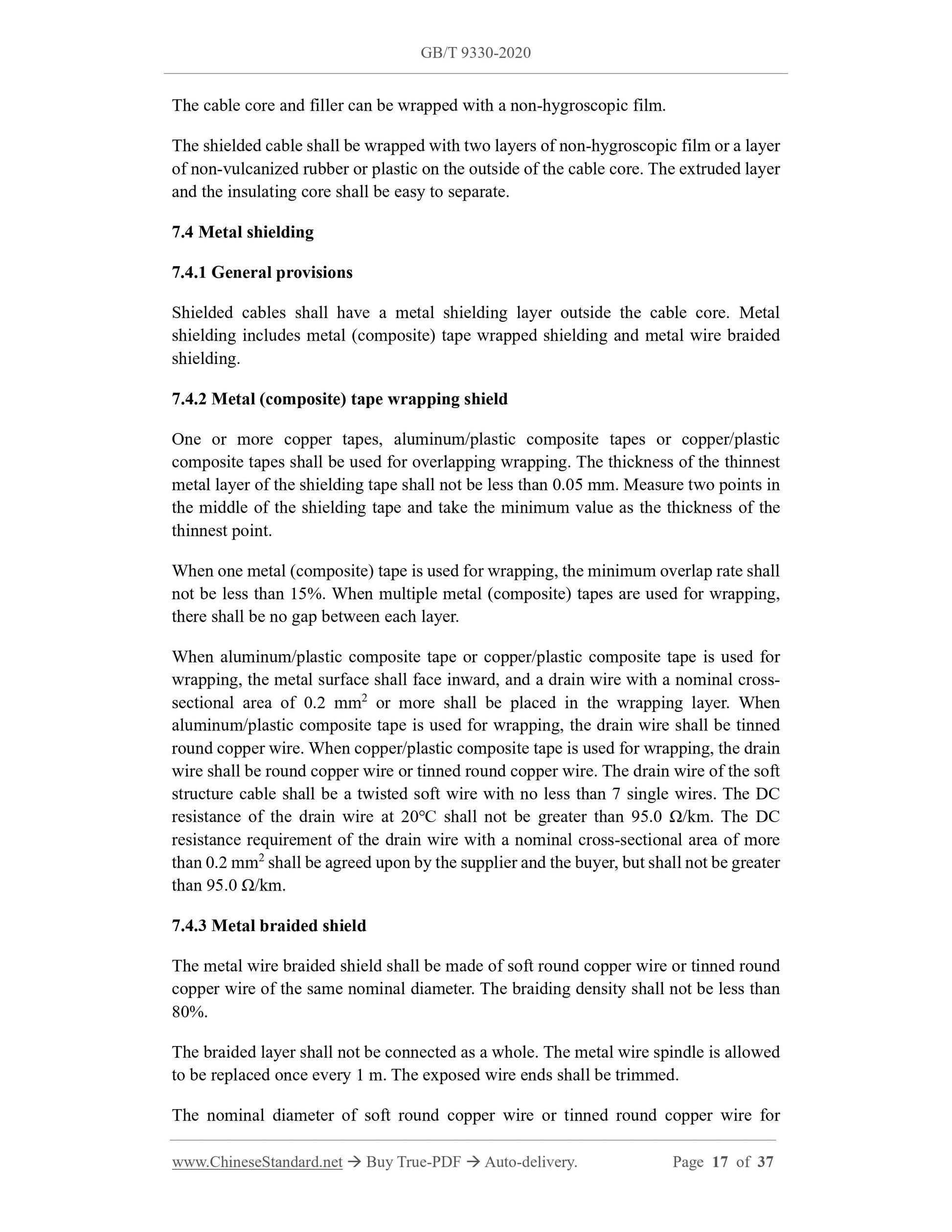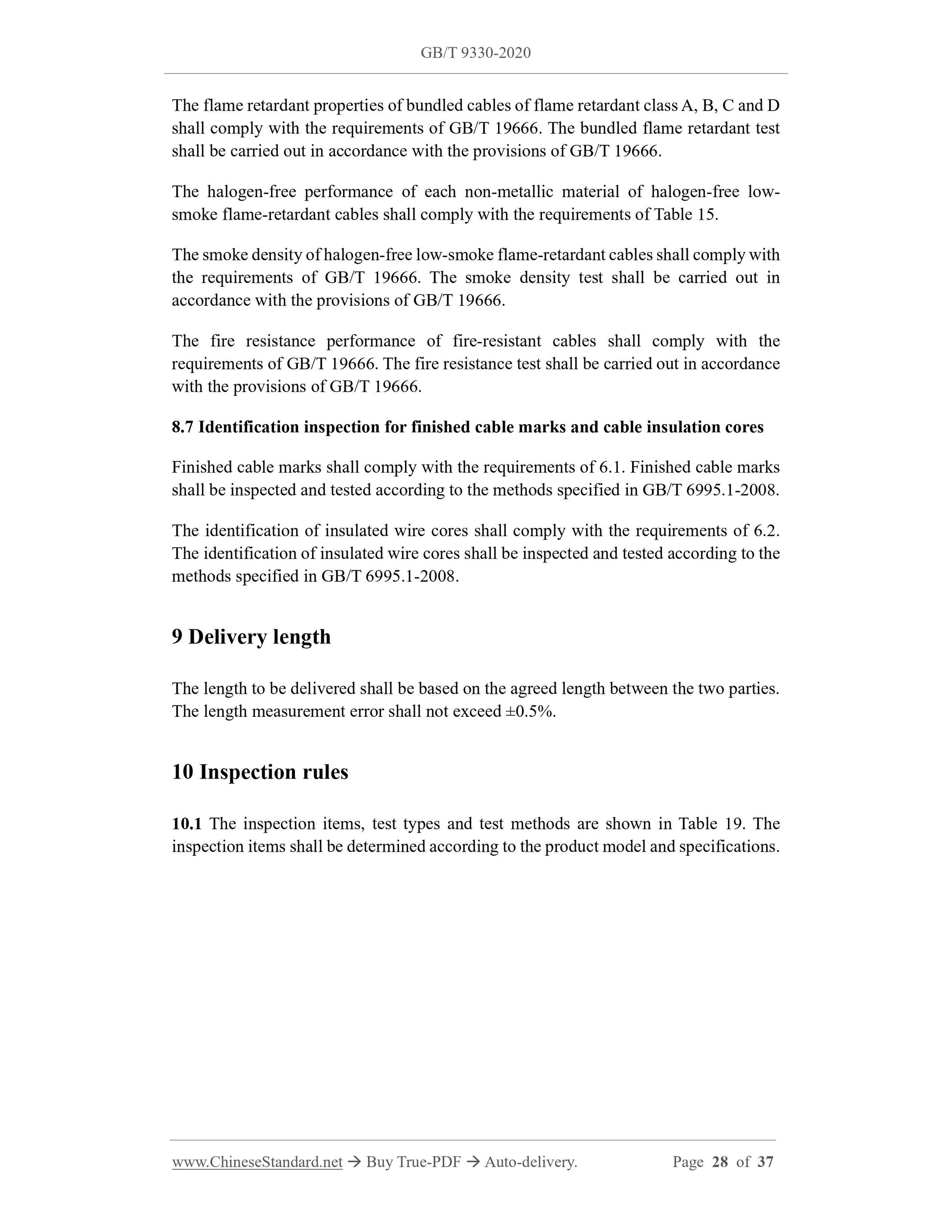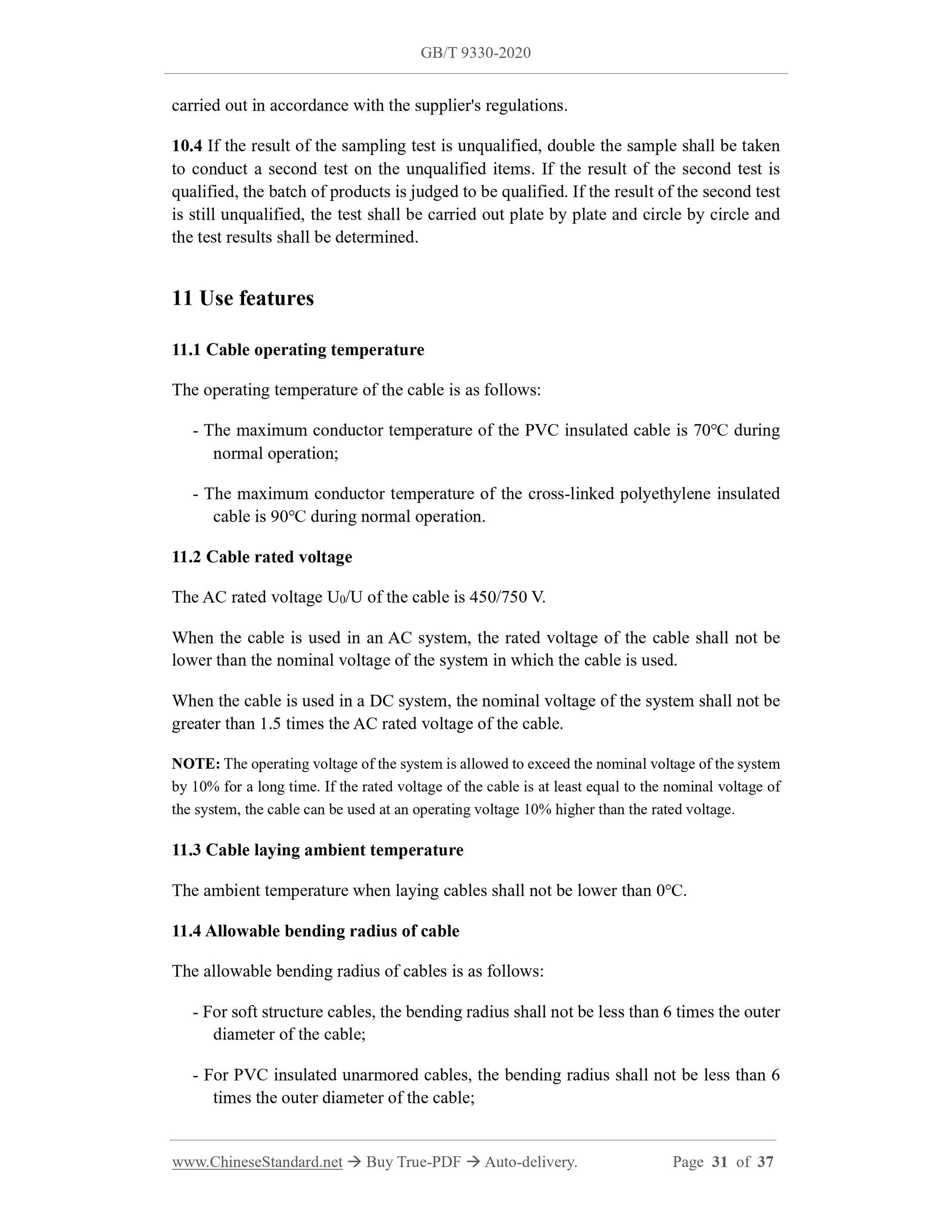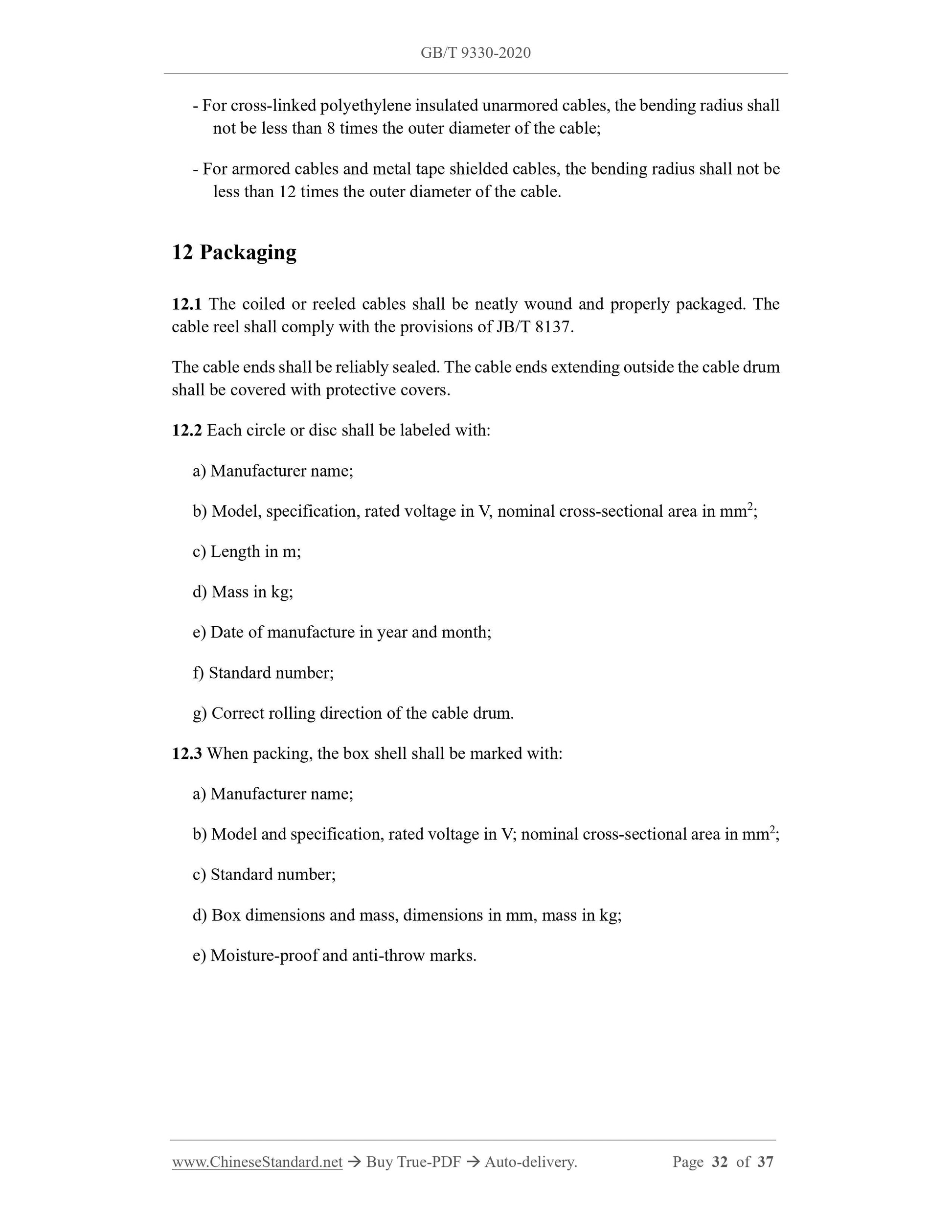PayPal, credit cards. Download editable-PDF and invoice in 1 second!
GB/T 9330-2020 English PDF (GBT9330-2020)
GB/T 9330-2020 English PDF (GBT9330-2020)
Precio habitual
$539.00 USD
Precio habitual
Precio de oferta
$539.00 USD
Precio unitario
/
por
Los gastos de envío se calculan en la pantalla de pago.
No se pudo cargar la disponibilidad de retiro
Delivery: 3 seconds. Download true-PDF + Invoice.
Get QUOTATION in 1-minute: Click GB/T 9330-2020
Historical versions: GB/T 9330-2020
Preview True-PDF (Reload/Scroll if blank)
GB/T 9330-2020: Plastic insulated control cables
GB/T 9330-2020
GB
NATIONAL STANDARD OF THE
PEOPLE’S REPUBLIC OF CHINA
ICS 29.060.20
K 13
Replacing GB/T 9330.1-2008, GB/T 9330.2-2008, GB/T 9330.3-2008
Plastic insulated control cables
ISSUED ON: MARCH 31, 2020
IMPLEMENTED ON: OCTOBER 01, 2020
Issued by: State Administration for Market Regulation;
Standardization Administration of the People's Republic of China.
Table of Contents
Foreword ... 3
1 Scope ... 5
2 Normative references ... 5
3 Terms and definitions ... 6
4 Product codes and representation methods ... 7
5 Cable names, models and specifications ... 9
6 Finished cable marking and cable insulation core identification ... 11
7 Technical requirements and test methods ... 13
8 Finished cables ... 25
9 Delivery length ... 28
10 Inspection rules ... 28
11 Use features ... 31
12 Packaging ... 32
Annex A (normative) Calculation method of assumed value ... 33
Plastic insulated control cables
1 Scope
This Standard specifies the product code and representation method, cable name and
model specifications, finished cable marking and insulation core identification,
technical requirements, test methods and inspection rules, usage characteristics and
packaging of extruded polyvinyl chloride and cross-linked polyethylene insulated,
polyvinyl chloride, polyethylene and halogen-free polyolefin sheathed control cables
with an AC rated voltage U0/U of 450/750 V.
This Standard applies to control cables used for fixed installation in control, monitoring
circuits and protection lines with an AC rated voltage U0/U of 450/750 V and below.
2 Normative references
The following referenced documents are indispensable for the application of this
document. For dated references, only the edition cited applies. For undated references,
the latest edition of the referenced document (including any amendments) applies.
GB/T 2900.10, Electrotechnical terminology -- Electric cables
GB/T 2951.11-2008, Common test methods for insulating and sheathing materials
of electric and optical cables -- Part 11: Methods for general application --
Measurement of thickness and overall dimensions -- Tests for determining the
mechanical properties
GB/T 2951.12-2008, Common test methods for insulating and sheathing materials
of electric and optical cables -- Part 12: Methods for general application -- Thermal
ageing methods
GB/T 2951.13-2008, Common test methods for insulating and sheathing materials
of electric and optical cables -- Part 13: Methods for general application --
Measurement for determining the density -- Water absorption tests -- Shrinkage test
GB/T 2951.14-2008, Common test methods for insulating and sheathing materials
of electric and optical cables -- Part 14: Methods for general application -- Test at
low temperature
GB/T 2951.21-2008, Common test methods for insulating and sheathing materials
of electric and optical cables -- Part 21: Methods specific to elastomeric compounds
-- Ozone resistance, hot set and mineral oil immersion tests
numbers. Except for the insulation cores identified by the green/yellow combination
color, each insulation core of the cable shall be of only one color.
6.2.1.2 Except for green/yellow combined color insulated cores, other insulated cores
shall not use green and yellow.
6.2.1.3 For green/yellow combination color insulated wire cores, one color shall cover
at least 30% and not more than 70% of the surface of the insulated wire core. The other
color shall cover the rest of the insulated wire core and remain consistent over the entire
length of the insulated wire core.
6.2.2 Color identification of cable insulation cores
When the cable insulation core is identified by colored insulation, the preferred color
spectrum for cables with five cores or less is:
- Two-core cable: no preferred color spectrum;
- Three-core cable: green/yellow combination, blue, brown, or blue, black, brown;
- Four-core cable: green/yellow combination, blue, black, brown, or blue, black,
brown, grey or orange;
- Five-core cable: green/yellow combination, blue, black, brown, grey or orange, or
blue, black, brown, grey, orange or other different colors.
When there are special requirements for color spectrum or other core number cables
need to be identified by colored insulation, the color spectrum of the cable shall be
determined by negotiation between the supplier and the buyer. If the buyer does not
make any requirements, the color spectrum of the cable shall be determined by the
supplier.
The various colors shall be easy to identify and resistant to rubbing. The color shall
remain basically unchanged after rubbing.
6.2.3 Digital identification of cable insulation cores
6.2.3.1 General requirements
When cable insulation cores are identified by numbers, the insulation shall be of the
same color and arranged in numerical sequence, except for green/yellow combination
insulation cores (if any).
The numbers shall be printed in Arabic numerals on the outer surface of the insulated
wire core. The color of the numbers shall be the same and have a clear contrast with the
insulation color. The writing shall be clear. The numbers printed with ink shall be
resistant to rubbing. The marking shall remain basically unchanged after rubbing.
The cable core and filler can be wrapped with a non-hygroscopic film.
The shielded cable shall be wrapped with two layers of non-hygroscopic film or a layer
of non-vulcanized rubber or plastic on the outside of the cable core. The extruded layer
and the insulating core shall be easy to separate.
7.4 Metal shielding
7.4.1 General provisions
Shielded cables shall have a metal shielding layer outside the cable core. Metal
shielding includes metal (composite) tape wrapped shielding and metal wire braided
shielding.
7.4.2 Metal (composite) tape wrapping shield
One or more copper tapes, aluminum/plastic composite tapes or copper/plastic
composite tapes shall be used for overlapping wrapping. The thickness of the thinnest
metal layer of the shielding tape shall not be less than 0.05 mm. Measure two points in
the middle of the shielding tape and take the minimum value as the thickness of the
thinnest point.
When one metal (composite) tape is used for wrapping, the minimum overlap rate shall
not be less than 15%. When multiple metal (composite) tapes are used for wrapping,
there shall be no gap between each layer.
When aluminum/plastic composite tape or copper/plastic composite tape is used for
wrapping, the metal surface shall face inward, and a drain wire with a nominal cross-
sectional area of 0.2 mm2 or more shall be placed in the wrapping layer. When
aluminum/plastic composite tape is used for wrapping, the drain wire shall be tinned
round copper wire. When copper/plastic composite tape is used for wrapping, the drain
wire shall be round copper wire or tinned round copper wire. The drain wire of the soft
structure cable shall be a twisted soft wire with no less than 7 single wires. The DC
resistance of the drain wire at 20℃ shall not be greater than 95.0 Ω/km. The DC
resistance requirement of the drain wire with a nominal cross-sectional area of more
than 0.2 mm2 shall be agreed upon by the supplier and the buyer, but shall not be greater
than 95.0 Ω/km.
7.4.3 Metal braided shield
The metal wire braided shield shall be made of soft round copper wire or tinned round
copper wire of the same nominal diameter. The braiding density shall not be less than
80%. ...
Get QUOTATION in 1-minute: Click GB/T 9330-2020
Historical versions: GB/T 9330-2020
Preview True-PDF (Reload/Scroll if blank)
GB/T 9330-2020: Plastic insulated control cables
GB/T 9330-2020
GB
NATIONAL STANDARD OF THE
PEOPLE’S REPUBLIC OF CHINA
ICS 29.060.20
K 13
Replacing GB/T 9330.1-2008, GB/T 9330.2-2008, GB/T 9330.3-2008
Plastic insulated control cables
ISSUED ON: MARCH 31, 2020
IMPLEMENTED ON: OCTOBER 01, 2020
Issued by: State Administration for Market Regulation;
Standardization Administration of the People's Republic of China.
Table of Contents
Foreword ... 3
1 Scope ... 5
2 Normative references ... 5
3 Terms and definitions ... 6
4 Product codes and representation methods ... 7
5 Cable names, models and specifications ... 9
6 Finished cable marking and cable insulation core identification ... 11
7 Technical requirements and test methods ... 13
8 Finished cables ... 25
9 Delivery length ... 28
10 Inspection rules ... 28
11 Use features ... 31
12 Packaging ... 32
Annex A (normative) Calculation method of assumed value ... 33
Plastic insulated control cables
1 Scope
This Standard specifies the product code and representation method, cable name and
model specifications, finished cable marking and insulation core identification,
technical requirements, test methods and inspection rules, usage characteristics and
packaging of extruded polyvinyl chloride and cross-linked polyethylene insulated,
polyvinyl chloride, polyethylene and halogen-free polyolefin sheathed control cables
with an AC rated voltage U0/U of 450/750 V.
This Standard applies to control cables used for fixed installation in control, monitoring
circuits and protection lines with an AC rated voltage U0/U of 450/750 V and below.
2 Normative references
The following referenced documents are indispensable for the application of this
document. For dated references, only the edition cited applies. For undated references,
the latest edition of the referenced document (including any amendments) applies.
GB/T 2900.10, Electrotechnical terminology -- Electric cables
GB/T 2951.11-2008, Common test methods for insulating and sheathing materials
of electric and optical cables -- Part 11: Methods for general application --
Measurement of thickness and overall dimensions -- Tests for determining the
mechanical properties
GB/T 2951.12-2008, Common test methods for insulating and sheathing materials
of electric and optical cables -- Part 12: Methods for general application -- Thermal
ageing methods
GB/T 2951.13-2008, Common test methods for insulating and sheathing materials
of electric and optical cables -- Part 13: Methods for general application --
Measurement for determining the density -- Water absorption tests -- Shrinkage test
GB/T 2951.14-2008, Common test methods for insulating and sheathing materials
of electric and optical cables -- Part 14: Methods for general application -- Test at
low temperature
GB/T 2951.21-2008, Common test methods for insulating and sheathing materials
of electric and optical cables -- Part 21: Methods specific to elastomeric compounds
-- Ozone resistance, hot set and mineral oil immersion tests
numbers. Except for the insulation cores identified by the green/yellow combination
color, each insulation core of the cable shall be of only one color.
6.2.1.2 Except for green/yellow combined color insulated cores, other insulated cores
shall not use green and yellow.
6.2.1.3 For green/yellow combination color insulated wire cores, one color shall cover
at least 30% and not more than 70% of the surface of the insulated wire core. The other
color shall cover the rest of the insulated wire core and remain consistent over the entire
length of the insulated wire core.
6.2.2 Color identification of cable insulation cores
When the cable insulation core is identified by colored insulation, the preferred color
spectrum for cables with five cores or less is:
- Two-core cable: no preferred color spectrum;
- Three-core cable: green/yellow combination, blue, brown, or blue, black, brown;
- Four-core cable: green/yellow combination, blue, black, brown, or blue, black,
brown, grey or orange;
- Five-core cable: green/yellow combination, blue, black, brown, grey or orange, or
blue, black, brown, grey, orange or other different colors.
When there are special requirements for color spectrum or other core number cables
need to be identified by colored insulation, the color spectrum of the cable shall be
determined by negotiation between the supplier and the buyer. If the buyer does not
make any requirements, the color spectrum of the cable shall be determined by the
supplier.
The various colors shall be easy to identify and resistant to rubbing. The color shall
remain basically unchanged after rubbing.
6.2.3 Digital identification of cable insulation cores
6.2.3.1 General requirements
When cable insulation cores are identified by numbers, the insulation shall be of the
same color and arranged in numerical sequence, except for green/yellow combination
insulation cores (if any).
The numbers shall be printed in Arabic numerals on the outer surface of the insulated
wire core. The color of the numbers shall be the same and have a clear contrast with the
insulation color. The writing shall be clear. The numbers printed with ink shall be
resistant to rubbing. The marking shall remain basically unchanged after rubbing.
The cable core and filler can be wrapped with a non-hygroscopic film.
The shielded cable shall be wrapped with two layers of non-hygroscopic film or a layer
of non-vulcanized rubber or plastic on the outside of the cable core. The extruded layer
and the insulating core shall be easy to separate.
7.4 Metal shielding
7.4.1 General provisions
Shielded cables shall have a metal shielding layer outside the cable core. Metal
shielding includes metal (composite) tape wrapped shielding and metal wire braided
shielding.
7.4.2 Metal (composite) tape wrapping shield
One or more copper tapes, aluminum/plastic composite tapes or copper/plastic
composite tapes shall be used for overlapping wrapping. The thickness of the thinnest
metal layer of the shielding tape shall not be less than 0.05 mm. Measure two points in
the middle of the shielding tape and take the minimum value as the thickness of the
thinnest point.
When one metal (composite) tape is used for wrapping, the minimum overlap rate shall
not be less than 15%. When multiple metal (composite) tapes are used for wrapping,
there shall be no gap between each layer.
When aluminum/plastic composite tape or copper/plastic composite tape is used for
wrapping, the metal surface shall face inward, and a drain wire with a nominal cross-
sectional area of 0.2 mm2 or more shall be placed in the wrapping layer. When
aluminum/plastic composite tape is used for wrapping, the drain wire shall be tinned
round copper wire. When copper/plastic composite tape is used for wrapping, the drain
wire shall be round copper wire or tinned round copper wire. The drain wire of the soft
structure cable shall be a twisted soft wire with no less than 7 single wires. The DC
resistance of the drain wire at 20℃ shall not be greater than 95.0 Ω/km. The DC
resistance requirement of the drain wire with a nominal cross-sectional area of more
than 0.2 mm2 shall be agreed upon by the supplier and the buyer, but shall not be greater
than 95.0 Ω/km.
7.4.3 Metal braided shield
The metal wire braided shield shall be made of soft round copper wire or tinned round
copper wire of the same nominal diameter. The braiding density shall not be less than
80%. ...
Share
